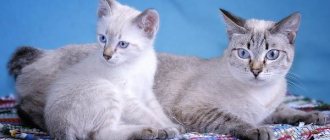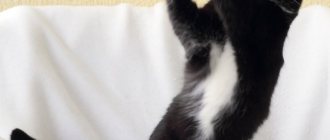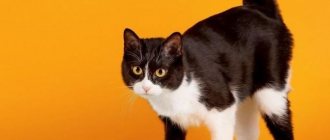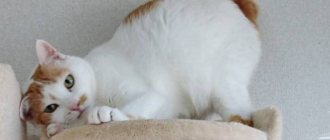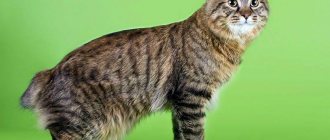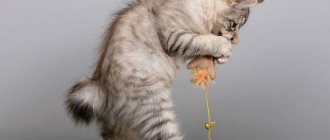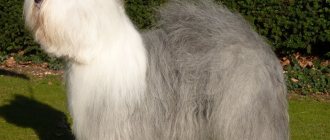Save article:
Bobtail cats
- hunters with excellent qualities, owners of such strong long hind legs and an amazing sense of balance, differ from other cats in the absence of a long tail.
The originality of appearance and friendly character traits have made tailless breeds desirable in many homes around the world.
In general, cats without a tail are divided into Manx and Bobtail cats. And these two groups are divided into subspecies.
There are many versions about how such beautiful cats were born. According to one hypothesis, cats with short tails appeared in the Land of the Rising Sun BC. Much water has passed under the bridge since then, and Japanese Bobtails became an officially recognized breed only at the beginning of the 21st century.
The mysterious Manx breed, which became the ancestor of other short-tailed cats, received its name in honor of the place where it was first discovered - on the Isle of Man, washed by the Irish Sea. From here, cats without a tail began their journey to other countries. It is not known for certain what is more responsible for the modern appearance of the breed - selection or mutation. There is an assumption that Manx cats are descendants of the British shorthair cat.
There is a mythical version about the appearance of tailless cats, which refers us to the Flood: Noah, letting a late cat in, was in a hurry, and inadvertently cut off its tail with the door.
Appearance of a bobtail cat
Bobtail cats are primarily identified by their tail. These cats have a short tail that is one third the length of a normal cat's tail. They have no two identical tails, which are usually 2-10 cm long and can be straight, curved or "spiral".
This breed can be short-haired or long-haired, with thick short fur or long, shaggy hair. Bobtail cats come in all colors and patterns.
Bobtails are a high-shedding breed and are not considered hypoallergenic - in fact, they can cause aggravation in owners with allergies. Cats have long hind legs, a strong athletic body, weight depends on the breed and ranges from 3 to 10 kg.
These cats mature slowly and may take longer than the average cat, 2–3 years, to reach full adulthood. The litter is rarely multiple.
How to choose a kitten
Purchasing a Kurilian Bobtail kitten is a responsible step that requires intuition and attentiveness from you! It is important to notice among the frolicking kittens exactly the one who will catch your heart. At the same time, you should not listen to either the words of the breeder or the advice of friends and relatives: this is your pet, so you only need to rely on your own premonitions.
The ideal age for purchasing a Kurilian Bobtail is three months. It is at this time that the baby begins to show independence and gradually weanses the habit of maternal care. In addition, a three-month-old “smoker” already has fairly balanced psychological health, so he quickly gets used to new family members.
If the pedigree of the future pet plays an important role, ask the breeder to introduce you to the necessary documentation or, more preferably, to the parents of the babies. This is one of the easiest ways to understand what to expect from your bobtail. The breeder is not talkative and does not demonstrate a desire to tell as much as possible about his charges? This is an alarming sign: it means he has something to hide from curious and persistent buyers like you.
When choosing a kitten, you should focus on its behavior among its brothers. Is your baby active and cheerful, happily getting involved in play and showing healthy curiosity towards you? This is your pet! Refrain from buying lethargic and timid kittens: this may lead to unpleasant consequences in the future.
Bobtail breed temperament
Bobtails are called cute, affectionate and obedient. These pets make excellent companions. They are not aggressive and get along well with children, older people and cat-friendly playmates.
Although this breed is playful, it is not very energetic. You can expect them to want to play every day, but only a little, otherwise they are ready to lie around and snuggle with their owner all day long. Lie by the laptop on the table while the owner types texts, keep your paw on the mouse and try to help your beloved.
True to their laid-back nature, these cats don't have super voices. The Bobtail will make noise when necessary, but you will hear more chirps and trills from it than a full-fledged meow. Attentive to the owner’s speech, the cat tries to repeat the intonation, which is sometimes quite funny.
The main characteristic of a bobtail cat is absolute affection. More than anything else, a bobtail wants to love—and receive that love! If you need a good companion pet, then this breed is suitable.
Gentle felines with short pom-pom tails are ideal for families and are sometimes offered as therapy animals to neurotics.
Attitude towards other animals
If other animals already live in the family, the bobtail will easily find a common language with them. He is equally welcoming to both cats and dogs, so it will not be difficult for him to establish contact with a mischievous dachshund and a formidable Maine Coon.
However, it is worth noting that the presented breeds categorically cannot tolerate ornamental birds and rodents. This is due to the developed hunting instinct.
Life needs of bobtail cats
Bobtails love to be loved and can give a lot of love in return. These cute cats need constant human interaction and do not do well when left alone.
Important! The Bobtail requires constant affection and cannot be left alone. Loneliness is a great stress for him, during which he behaves completely unpredictably.
If you need to go somewhere, it is better to take your pet with you. Although ordinary cats become attached to a place, not to an owner, and do not like to leave somewhere. Therefore, if you spend a lot of time on the road, you should know that the bobtail travels well and will be an excellent travel companion.
These social cats get along with almost everyone and don't mind homes that are frequented by guests. They rush to the door to greet the guests.
Because cats crave companionship, they will try to make friends with almost anyone—you'll need to keep an eye on your bobtail to make sure he doesn't go outside to meet less friendly animals and people.
To satisfy your kitten's curious nature and social needs, you need to train him to walk on a leash and take him on walks around the neighborhood.
Although bobtail cats are not described as very active, they have a strong, athletic body. Bobtails have particularly muscular hind legs and can jump up to 2.5 meters. Giving your pet a tall cat tree will give him a safe and comfortable place to land when he wants to frolic.
Origin
The history of bobtails begins on the thresholds of Buddhist temples. There, on the tops of the Himalayan mountains, lived white temple cats, guarding the shrines of the monks. These animals, distinguished by their courage and high intelligence, gradually migrated from the Himalayas to the territories of eastern countries. So, in Japan, keeping such cats at home was an honor; they were groomed and cherished. However, the semi-wild cat nature took over and they left.
The journey brought the temple cats to the Kuril Islands. Outside of human homes, cats took care of themselves. Hunting and the need for defense forced the Japanese Bobtail to change. An increase in size, an unusual color for the ancestor, a lack of fear of water and claws that cats never fully retracted - these are the changes the breed has undergone.
Non-retractable claws are one of the features of bobtails. Thanks to this, today smokers running around the apartment make clicking sounds.
With the arrival of people from Siberia in the Kuril Islands, the bobtails had a new neighbor, with whom he immediately found a common language. The newcomer turned out to be a large, long-haired domestic Siberian cat. Thanks to the union of these two breeds, the modern standard of the Kuril Bobtail emerged.
Bobtail cat care
Caring for a bobtail is easy. Brushing once or twice a week is necessary to keep the coat smooth and healthy. The brush should be selected based on your pet's coat type. Remember to trim your nails regularly and check and clean your ears regularly in the morning.
The Bobtail is a relatively low-energy breed and does not require much exercise. Owners don't have to go out of their way to get these cats moving, but one-on-one play can be encouraged and appropriate toys offered.
Because they are intelligent, these cats can be easily trained to perform simple tasks such as using a litter box or scratching post. They can also be taught to play games like “Fetch!” and walk on a leash.
Socialization with this good-natured breed should be easy. Bobtails who are introduced early to people and pets usually get along easily and greet unfamiliar faces.
All types of bobtails should be fed cat food recommended by a veterinarian. It is important not to overfeed your cat, as this can lead to obesity.
Feeding pets
Bobtails are very sensitive to the quality of food, both natural and ready-made. Breeders recommend a natural diet for bobtails with a sufficient amount of meat and sea fish. Let's list the natural products that are required and prohibited on the short-tailed fish menu:
| Can | It is forbidden |
| Raw frozen beef, boiled boneless chicken. Boiled low-fat sea fish. No bones. Chicken or beef by-products - hearts, lungs, liver, kidneys, raw or boiled. Raw or boiled egg yolk, pure or grind with kefir, add to porridge. Fermented milk products: sour cream, kefir, fermented baked milk, yogurt, cream - all medium fat, without sugar or additives. Fresh, non-acidic cottage cheese can be mixed with sour cream or raw egg yolk. Cereals: rice, buckwheat, steamed oat flakes, wheat groats. Boiled cereals are mixed in a 1:2 ratio with boiled meat or boiled fish. Vegetables, raw or boiled: carrots, cauliflower and others. Mix in a 1:2 ratio with boiled meat or boiled fish. Greens, sprouted wheat grains, special grass for cats. | Food from the human table. Salted, fried, smoked food. Pork, lamb, goose, duck. River fish, seafood. By-products – spleen, chicken necks and bones. Egg white. Butter, salted cheese. Citruses, kiwi, pineapple, persimmon. Nuts and beans. Potatoes, onions, garlic, tomatoes, eggplants, mushrooms. Confectionery. Bread and other baked goods. Tea coffee. Alcohol. |
The peculiarity of the intestines does not allow bobtails to consume dairy products and potatoes.
The proportion of proteins, fats and carbohydrates should be as follows - 60-70% protein, 10% fat, 20-30% carbohydrates. It is best to check with your veterinarian for serving size.
Ready-made foods are also suitable for bobtails, but they should be premium foods, since cheaper ones cannot always sufficiently provide the animal’s body with nutrients. The serving size must correspond to the standards indicated on the packaging.
Bobtail cat health
Bobtails have a lifespan of 13–15 years and are a relatively healthy breed due to their natural development. Cases of being born without a tail can lead to problems with the spine.
Due to the unequal length of the front and rear legs, hip dysplasia, an inherited disease that can cause lameness and arthritis of the hip joints, develops with age.
Tailless bobtails may develop a spinal disorder in old age that will affect their ability to control bowel movements.
Breeders screen kittens for health problems, but it is important that animals are monitored regularly until adulthood. Health problems may go undetected until the very end of a cat's life. Regular examinations by a veterinarian will be the basis for a calm life for the owner and his pet.
Content Features
In general, caring for short-tailed cats is not very different from general grooming requirements. The only nuance is the need for washing with special products approximately once every two weeks. After water treatments, your pet’s fur coat should be thoroughly combed with special combs or a furminator.
We must remember that, regardless of breed, these are very active cats that need intense physical activity. They make ideal playmates for children.
Bobtails appreciate attention, are sociable and are ready to spend all their time in the company of their owners. They are rarely and reluctantly left on their own, they get bored and may even get sick.
Representatives of bob-tailed cats tend to have poor health. They need a balanced diet rich in micronutrients. It may take a long time to find the right diet. Read about how to choose the right diet for your cat on our portal.
It is important to maintain contact with the supervising veterinarian and conduct timely examinations and vaccinations.
If the animal is not suitable for further breeding, it must be sterilized.
Types of bobtail cats
The types of bobtails that are known today began naturally at different times. The photo shows the main varieties of bobtail cats:
American, bred by felinologists in the early 80s. It took two decades to create this variety. Features include striped color, large size, and “knots” of the tail.
Karelian, thick coat with undercoat, close-set eyes, varied color except spots. A successful hunter, a loyal friend, behavior close to that of a dog.
The Kamchatka bobtail cat may have evolved from the Japanese bobtail. Luxurious fur, round eyes.
Mekong, bred in Thailand. Features: small size, characteristic “Siamese” color, slanting blue eyes. Capable of protecting the house like watchdogs.
Manx, a British variety of almost tailless cat, is large, weighing up to 7 kg. The coat is thick and striped in color. The eyes are large and round, creating a surprised look.
The pixie bob, a smaller version of the natural lynx, has a short tail and up to 7 toes on the hind feet, common in Canada and the United States.
Japanese, known since the 16th century, the breed was recognized in 1993. Small specimens weigh up to 4 kg, with a curved tail. The color is white, with black or red spots. The eyes are slanted, wide open, often of different colors.
Kitten in the house
Kurilian Bobtail kittens are active and very playful. This breed is relatively new. Its standards are at the approval stage. Therefore, it is important that the breeder is trustworthy and can confirm that the Kurilian Bobtail kitten meets all standards.
The shape of the tail should not be misleading. It can also become deformed in ordinary kittens in the embryonic state. It will be an ordinary cat with an unusually short tail.
When choosing a kitten, you need to look at its color and tail shape. When purchasing, it will not be superfluous to count the vertebrae on the tail. Kurilians have from 2 to 8. The disadvantage of the breed is the tail is up to 3 cm and longer than 8 cm.
Be sure to ask for a veterinary passport for the kitten. Vaccinations and their dates are noted there. The nursery issues a certificate for the kitten. In some cases, a pedigree is given instead. The buyer must necessarily require the conclusion of a purchase and sale agreement. He will confirm the fact of purchase.
Buying a kitten secondhand is always risky. Be sure to carefully examine him and inquire about his state of health. Ears and eyes are carefully examined. They should be free of secretions and parasites. Then the skin and fur are examined. The skin should be clean and the coat should be thick and shiny.
If the kitten is healthy, it is active and inquisitive. He has sparkling eyes. He should not be overly plump or thin. When palpating, the collarbones and ribs should not stand out. A large tail may be a symptom of the presence of worms. The paws need to be examined. Smokers' claws do not fully retract.
What to feed a Kurilian Bobtail kitten
You need to ask the breeder carefully about this. At first they give milk, then you can gradually introduce special food for kittens. It must be Premium class. They switch to it at about 2 months.
A Kurilian Bobtail kitten needs to be fed 5-6 times a day to make it stronger. From three months you can completely switch to cat food. Gradually you need to achieve a balanced diet.
Weight by month
The Kurilian Bobtail should weigh approximately this way as it matures:
- 45 days – 730 g for a cat, 800 g for a cat.
- 2 months – 1100-1500g.
- 6 months – 3 kg for a cat, 4 kg or more for a cat.
- An adult animal reaches a weight of 3.5-5.5 kg in cats, 5-7 in cats.
What to call a smoker
These large animals respond well to short and medium names. For Kuril cats, nicknames should be as masculine as possible. Suitable names for them: Billy, Johnny, Bob, Mebu, Teri, Teddy, Leni, Archie, Ollie, Sad, Chad, Cherry
But names for cats need to be more melodic. They respond well to hissing and dull sounds. Can be named according to color - Tiger, Lynx, Spot.
The following names may be suitable for cats: Bonnie, Sherry, Kitty, Nessie, Emmy, Aida, Obi, Sweetie, Sally, Tilly, Jackie and others.
Interesting facts about the bobtail breed
Bobtails are like dogs when they wag their short tail to express their happiness.
The difference in the length of the front and hind legs and the short tail make bobtails funny, sometimes they can't keep their balance and just flop down on the floor.
The desire to imitate the owner brings the intonation of the cat’s meow to perfection; it can begin to “talk” to the owner.
The history of the appearance of tailless cats
All tailless cats, with the exception of hybrids and pixie-bobs, are the result of natural mutation that occurred in limited geographic ranges. Depending on the place of origin, they are divided into 2 groups:
- Manx cats born in the British Isles;
- bobtails that appeared on the territory of Japan, which for a long time led a predominantly closed lifestyle.
The relationship of these animals has not been proven, but it has not been disproved either. One part of felinologists is inclined to the theory of parallel and separate development of each of the groups, and the second - to the theory of the movement of “mustaches” from one area to another along with people.
INTERESTING!
According to one legend, the bobtailedness of cats is due to the slowness of their distant ancestor, who jumped into Noah’s Ark at the very last moment. Because of this, the closing door pinched his tail.
British breeds
The first mention of cats without a tail dates back to the mid-18th century. Representatives of this group appeared on the Isle of Man, located between Great Britain and Ireland. Local breeders quickly fixed the mutation in new generations, arousing great interest among breeders from Europe and America.
In appearance, Manx cats resemble the classic chubby-cheeked “British”. Most of them have short hair, but in Canada there is also a separate long-haired variety.
Japanese breeds
In Japan, bobtails are called maneki-neko, or “alluring cat.” Ceramic and porcelain figurines with their image are often displayed in shop windows, restaurants and other establishments in order to attract good luck. Despite the modern reverence for cats without a tail, the alleged history of their appearance is rather dark and sad.
The Japanese believed that in old age, domestic cats turned into nekomata - dangerous demons (youkai) that kidnapped and ate people. A distinctive feature of these creatures was their forked tail, so enterprising owners began to cut it off for their pets in childhood.
The systematic destruction of the long tail led to a genetic mutation. Kittens with a fluffy pompom began to appear, so the breeders just had to secure its inheritance.
